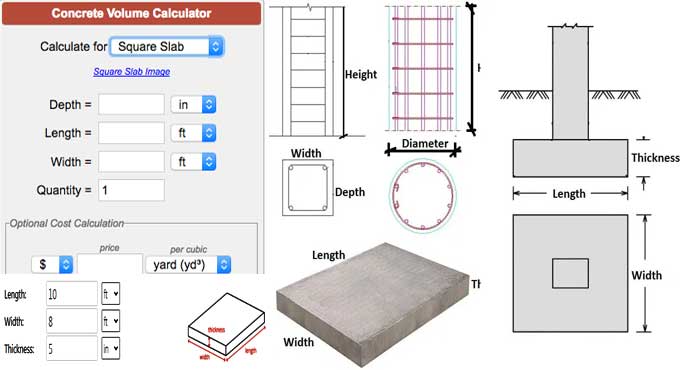
A Workflow and Cost Calculation for Concrete in Construction

Usually sold by the cubic yard, concrete is a mix of sand, gravel, and cement. However, pre-mixed concrete is also available. Since you often only get one attempt at pouring, you need to estimate the material amount as accurately as possible. Make sure that the installation team is ready to begin the installation as soon as the truck arrives so that the installation can begin without wasting time setting up the truck.
Workflow
The slab, footing, or column should measure for length, width, and height. Calculate the concrete needed for each pour if the area is complex or multiple pours are required. To measure slabs that are not simple rectangles, you might want to break them into separate sections and measure each separately.
1. If they haven't already converted to feet, do so. Converting inches, yards, or meters to feet is easy with conversion calculators. You multiply the width times the length times the height (W * L * H) to figure out how many cubic feet there are.
2. From cubic feet, multiply the volume by cubic yards. Calculate how many yards of concrete you need by dividing the cubic footage by 27.
3. If you can't find a supplier that sells fractions of a yard, round up to the nearest yard. You should ask your supplier if they will sell a partial yard of material, but most don't.
4. When ordering concrete for smaller projects, estimate how many bags of premixed concrete you will need.
5. There is a comparison of the coverage of various premix bags. The average cubic yard of concrete can be filled with 90 forty-pound bags, 60 sixty-pound bags, or 45 eighty-pound bags.
6. 5%-10% additional material should be added to compensate for spills, settling, and waste. If you're short of concrete, you'll be able to complete your project in a single pour.
What is Concrete Cubic yard?
Approximately three feet or one yard is the length of an edge on a cube. Maybe you're wondering what a cubic yard of concrete makes of. There are 47 cubic feet in a cubic yard, 46,656 cubic inches in cubic yards, or 45 80-pound bags in cubic yards.
Formula - Rectangular & Square
In rectangular spaces, the volume equals length time?s width time?s height. Instead of height, measure thickness for slabs.
Size x length x height = volume
yds3 = width ft ? length ft ? height ft divided by 27.
Circular
A circle's volume equals pi times its radius squared times its height.
Volume = p ? radius ? radius ? height
yds3 = p ? radius ft ? radius ft ? height ft divided by 27
Where p = 3.14.
Concrete Bags Requirement
The method of calculating yards has been covered already, but if you have a small project, then you can use premixed concrete bags instead. There are premixed concrete bags available from companies has 40 pounds, 60 pounds, or 80 pounds.
When you are working on smaller projects, bags would be a practical and cheaper alternative to ready-mix. Having to mix bags on-site will be a challenge if you put in a large slab or pour a lot of footings. When the project is mid-size, and you can pour the concrete all at once, ready-mixed concrete from a truck is more cost-effective than bags.
Calculating Concrete Cost
It depends on the project's size, scope, location, and type of concrete you use on the cost of concrete work.
Yard Concrete Cost
The average cost of ready-mix concrete is 115 dollars per yard, although it can cost 150 dollars or more depending on your location and the mix. For smaller projects, you might charge for delivery or short-load fees associated with ready-mix.
Average per Bag Cost
Bags of premixed mortar for small projects usually cost between 2.50 and 7 dollars.
Concrete slabs average between 6 dollars and 20 dollars per square foot. Labor costs are also involved in preparing the site, pouring, and finishing the concrete in addition to concrete and materials.
In terms of price, a standard brushing finish is likely to be on the low end, while colored decorative finishes will likely be on the higher end. Obtain a more accurate estimate for the cost of concrete installation by getting a professional estimate from local contractors.
To learn more, watch the following video tutorial.
Video Source: Civil Study
Final Thought:
Pouring concrete takes place before the arrival of the truck to create the edges of a slab or contain footings, measure, and layout the site. To prevent future cracks, reinforce concrete with fiber steel mesh or rebar.
Calculate the amount of reinforcement you need for your project by using your rebar material and reinforcing mesh calculators.
Click Online Concrete Calculator


